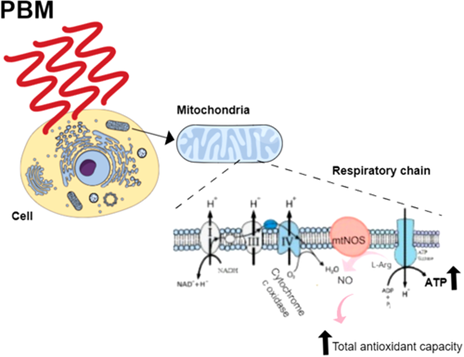How Photobiomodulation can Save You Time, Stress, and Money.
Wiki Article
Some Known Questions About Photobiomodulation.
Table of ContentsGetting The Photobiomodulation To WorkFascination About PhotobiomodulationSome Of PhotobiomodulationThe 6-Minute Rule for Photobiomodulation
Laser therapy is a medical therapy that makes use of focused light to promote a procedure called. During PBM, photons go into the tissue and interact with the cytochrome c complicated within mitochondria. This interaction causes an organic cascade of events that leads to a boost in mobile metabolic process, which can as well as increase the healing procedure.There is agreement that the application of a therapeutic dosage of light to impaired or useless cells results in a mobile action mediated by mitochondrial mechanisms. Photobiomodulation. Researches have actually revealed that these adjustments can impact pain and swelling, as well as, cells repair service
Adjustments in ATP, reactive oxygen types and nitric oxide adhere to light absorption by Cc, O. These effects are redox state and dosage reliant. In hypoxic or otherwise stressed out cells it has been shown sometimes that complying with, nitric oxide is launched, ATP is increased and oxidative stress is decreased [27-31]

The Basic Principles Of Photobiomodulation
PBM gadgets have actually been cleared for marketing by FDA with the Premarket Notification/510( k) process as adjunctive devices for the momentary alleviation of discomfort. These clearances were based upon the presentation of medical information to sustain such claims (Photobiomodulation). In this treatment, a light source is placed near or in call with the skin, permitting the light power (photons) to pass through cells where it engages with chromophores situated in cells causing photophysical and photochemical changes that cause alterations at the molecular, mobile and tissue levels of the bodyRemarkably, recent research study indicates that light can enhance efficiency in regular cells and cells. The prospective applications of PBMT are many and are being discovered experimentally at the fundamental scientific research, pre-clinical and scientific degree. The current clinical uses are for the relief of discomfort and inflammation and the treatment of sporting activities injuries.

The treatment criteria and number of sessions needed for PBMT are reliant upon place and cause. PBMT generally calls for even more than one treatment for optimal discomfort Website relief.
Photobiomodulation - Truths
Treatment criteria for PBMT were initially established making use of cells in vitro and in little animal models. These therapy specifications normally had a reduced irradiance and fluence and worked well for cutaneous applications. Nonetheless when clinicians began to use PBMT to treat structures that were situated deeper in the body, they utilized these parameters with unfavorable results.
We currently recognize that these unfavorable research studies was because of wrong gadget and treatment parameters for transcutaneous treatment of deeper frameworks. Recent advances in laser therapy gadgets and even more research into the ideal dosages have actually considerably improved the results of PBMT. For treating deep cells, the wavelength of light made use of figures out the deepness of penetration right into a tissue.
It is crucial that a clinician makes use of the suitable wavelength of light and specifications to deal with a condition. One wavelength and one set of therapy criteria will certainly not be effective for all conditions. Unfavorable side impacts have not been reported from the use of PBMT.
The Buzz on Photobiomodulation
In the very first experiment, Dr. Endre Mester, made use of shaved rats and observing exactly how the laser influenced their capability to grow hair contrasted to the group that was not getting LLLT. He located that the group of computer mice getting LLLT had the ability to expand their hair back a lot more redirected here quickly than the group of mice that really did not get LLLT (Hoon C, et alia; 2012).This therapy is described by doing this to set apart the difference in between the lasers some professions use to reduce (eg. in surgical procedures, or oral procedures). Low-level light treatment is pain-free, non-invasive therapy. It is made use of to lower swelling, swelling, and persistent joint conditions, lower discomfort and accelerate wound recovery of nerves and cells (Hoon C, et alia; 2012).
LLLT has a biphasic response, suggesting that reduced dosages are generally attended be much more valuable than higher dosages. That being claimed, dosages greater or lower than the optimum dose Extra resources doesn't influence (Hoon C, et alia; 2012). For this reason, it can be difficult to have studies on LLLT with a lot of criteria.
Some companies incorporated both (LED and laser) to supply a more all-round therapy given that lasers can permeate much deeper than LED and infrared light (Norman Doidge, The Brain's Method of Recovery, 2015). Throughout treatment, the area that is being treated is subjected to LED light from a Bio, Flex Laser, which is at 660 nm wavelength, adhered to by infrared light at 830-840 nm wavelength.
Report this wiki page